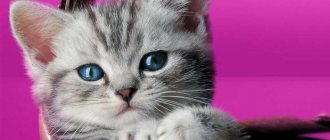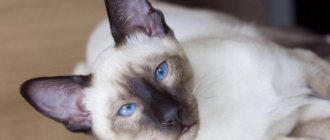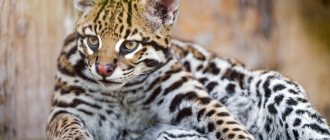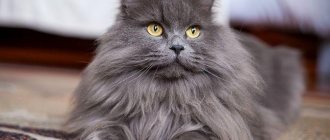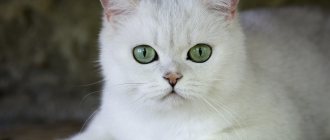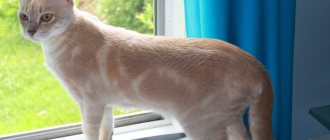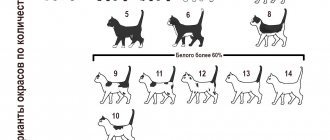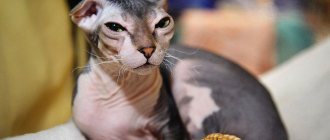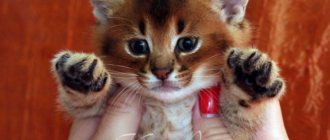Asian leopard cat in nature
The Asian wild cat lives in Southeast Asia and the Far East.
Habitat: tropical forests, undergrowth, coniferous and deciduous forests, river valleys. Wild cats “consider” their territory to be 2-3 km2. They mark her with excrement. They make their dens in hollows or burrows left by other animals. Often one predator has two shelters.
Leopard cats can swim and sometimes catch fish and crayfish. They usually hunt small rodents, birds, lizards, and large insects. They can destroy bird nests.
There are several subspecies of the Asian leopard cat:
- Bengali;
- Chinese;
- Himalayan;
- Far Eastern.
There are 20 subspecies in total. Most of them are listed in the Red Book and are on the verge of extinction.
Behavioral characteristics and habitat
Steppe cats are crepuscular animals. They usually go hunting in the evening. It feeds on small rodents, birds and their eggs, lizards, insects and amphibians. Hunts from ambush, tracking prey and attacking in one leap. Before hunting, it licks itself thoroughly, hiding its scent. As a rule, these cats spend the day hiding in the burrows of porcupines or foxes or hiding in dense bushes.
They have enough enemies in nature: people, hyenas, jackals, dogs, large cats. When meeting an enemy, the steppe cat, if it does not have time to escape, arches its back, turns sideways to the danger, bristles its fur, presses its ears back and hisses, trying to appear larger and more terrible. When attacked, she falls on her back, fights off with her claws and howls furiously.
Steppe cats fight back furiously when attacked
Most of the time, these cats are silent and do not make unnecessary sounds. The range of their “speech” is quite large: snorting, hissing, grumbling, meowing, howling. They become most vocal during the rutting period.
Steppe cats live alone, meeting only during the mating season. However, at the same time, they have rich facial expressions and a wide variety of poses through which they communicate with their relatives.
A female steppe cat most often gives birth to three kittens.
The mating season for steppe cats usually begins at the end of January and lasts until the beginning of March. At this time, the males are unusually active, chasing each other with loud meows and fighting for the female.
Pregnancy lasts 2 months. From 2 to 6 cubs are born, which the female raises alone. Kittens are born blind and deaf, and gain sight and hearing by 9–12 days of age. The female feeds them with milk for up to 2 months, then switches them to meat food. From 3 months, cubs go hunting with their mother. The cubs go “free swimming” at the age of 6–9 months, when the change of teeth from milk to molars ends.
Steppe cats become independent at 6–9 months
Steppe cats become sexually mature by the age of one year, but do not participate in reproduction until the age of 2 years. In captivity they often live up to 8–10 years; in the wild they live much shorter. They settle, as a rule, next to colonies of rodents, and often next to human settlements.
Where can you find the steppe cat:
- In the steppe, desert and sometimes mountainous regions of Africa.
- In Western, Middle and Central Asia.
- In Northern India.
- In Transcaucasia.
- In Kazakhstan.
- The steppe cat is also found on the territory of Russia, in semi-desert areas or floodplain bushes of the Astrakhan region, where it usually stays close to water.
Prairie cats are territorial. The hunting grounds of one animal can range from 2 to 5 km2. Females tend to have a smaller territory.
The habitat of the steppe cat - Africa and Central and South Asia - is declining very quickly
Description of the species
The Asian cat is slightly larger than domestic cats. Sizes depend on area:
- Weight 5-7 kg, body length 45 cm (Indonesia).
- Weight 17-10 kg, body length 60 cm (Far East).
- Weight 2-3.8 kg, body length 39 cm (northwestern regions of China).
Height is about 40 cm. Males of this species are larger than cats. In winter, male Amur leopard cats can gain weight up to 15 kg.
The body of miniature predators is elongated, the tail is long from 17 to 20 cm. As a percentage, it makes up 50% of the body length. In representatives of the species living in the vast expanses of the Ussuri taiga, it can reach 40 cm.
The legs are long and muscular. The forelimbs are slightly shorter than the hind limbs. Thanks to this, the Asian leopard cat can perfectly jump around villages and pursue its prey for a long time. There are small membranes on the paws, due to this, predators swim well and move easily on slippery ground or grass.
The following exterior features are distinguished:
- The head is narrow and short. The nose is large, the lobe is slightly forked. In color it can be either pink or brick. Lips black.
- The ears are a rich brown hue, rounded at the ends, with a white mark on the outside. Its felinology is called a wild spot.
- The eyes are large, round, brown or golden, amber, yellow. Rarely do “northern” cats have a gray-blue tint. There are small white spots on the fur under the eyes.
The fashion has dark stripes running from the eyes to the ears. And there are white spots near the mouth. The mustache is also light.
Nutrition
In terms of food, the forest cat is also a gourmet and a glutton: he prefers to eat fresh prey; his daily diet can consist of a dozen small rodents. An adult can consume up to a kilogram of food daily.
Top articles: Chindesaurus
The victims of cats are:
- field mice
- Sony
- partridges
- pheasants
- coots
- gray rats
- muskrats
- trout
- nutria
- rabbits
- moles
- squirrels
- shrews
- caresses
- martens
- lizards
Once upon a time, cats living in the steppe regions caught bustards and even eagles; sometimes a large individual can defeat a small roe deer. Predators living on the banks of rivers and the inhabitants of floodplains hunt for fish and aquatic animals.
When approaching human habitation, cats free the surrounding area from the rodents that have settled there. While helping people in this way, they are doing harm at the same time by eating poultry. They cause harm to wildlife by destroying rare birds in protected areas (for example, in the Caucasus).
The meal process resembles that of an ordinary cat, but the front paws do not fall to the ground. It chews its prey, biting off one piece at a time, starting from the side of the carcass.
Coat and color
Asian leopard cats are shorthaired. The fur is thick, the guard hairs are soft. The color will depend on the habitat:
- Animals living in the southern regions of their range have a yellowish base coat color. The spots on the fur are dark brown, almost black. They are shaped like rosettes or brush strokes.
- The inhabitants of the Ussuri taiga and northwestern China have a grayish base fur color. The spots are lighter, red-brown in color. They are shaped like horizontally elongated circles. The ancient Chinese called the animals coin cats for their similar color. The spots on their skin resembled the coins then in circulation.
Regardless of the region where they live, stripes and spots are located the same way across a cat’s body. The fur on the belly and chest is white or cream. There are horizontal dark stripes running along them, of medium thickness. On the back, small spots merge into lines or chains. Starting from the middle of the tail, there are light ring stripes towards its tip. The tip of the tail is always black. The largest spots are unevenly colored, their edges are darker than the middle.
History of the discovery of the ALA species
In 1958, Russian scientist Nikolai Severtsov made the first classification of wild cats of Southeast Asia, and in 1917, English zoologist Reginald Pocock confirmed and developed this classification. They divided the Asian or Oriental cats (Prionailurus) into 4 species, one of which was the Asian leopard or Bengal cat. In Latin it is called Prionailurus (Felis) bengalensis, after the name of the region of Bengal in India where Europeans first saw these animals. By the way, R. Kipling’s book “Mowgli” was written about those places. Now this territory - in the delta of the Ganges and Brahmaputra rivers - is divided between India (West Bengal) and Bangladesh (East Bengal). The region has retained its roots; it is inhabited by Bengalis who speak the Bengali language.
The Bengal cat is the most numerous wild cat in Asia.
The cat Prionailurus (Felis) bengalensis has many names: Chinese cat, Ellata cat, Javan cat, dwarf cat, Wagati cat, coin cat, Asian leopard, Far Eastern cat, etc.
The Chinese called this cat “coin” because the spots on its skin resembled the coins that were in circulation in Ancient China.
This number of names is due to the breadth of geographical distribution and the number of subspecies living in different parts of Asia: Indian, Himalayan, Chinese, Far Eastern and others. In total, there are about 20 varieties that differ in color shade and the shape and size of spots: cats living in warm regions with a humid climate have a brighter skin color (yellow-brown with black spots) than those living in the north (yellowish-gray tones with red - brownish spots). All Asian leopards have spots that are elongated horizontally.
Character
The Asian leopard cat is cautious and shy. In the wild, it never attacks first, preferring reliable shelters to open confrontation. Animals are masters of camouflage; they are difficult to see in thickets of bushes or tall grass.
In the wild, predators prefer to live alone. They form pairs only for reproduction. The cat lives with the kittens for about a year.
Domesticated animals get along well with members of their own species. They get along with domestic cats. Asian cats are cold towards dogs. Hamsters, decorative rats, guinea pigs, and parrots are perceived by animals as prey.
The leopard cat singles out one owner for itself, to whom it is attached. She gets along with other family members too. But he doesn't like strangers. The domestic predator rarely shows aggression towards strangers, preferring to hide from them.
Tamed cats and cats are very smart. They are easy to train. In childhood and adolescence, animals are playful and playful. They can run around the house for a long time, hunting for any small objects in sight.
Asians are nocturnal predators. Even living together with a person, they do not change their habits. The owners will have to adapt.
Animals require attention, otherwise their character and behavior deteriorate. They run wild and behave warily towards their owner. They may perceive his actions as a threat and defend themselves.
Despite their predatory nature, leopard cats and cats do not tolerate stress well. Moving and a tense situation in the house have an extremely bad effect on them. Nervous animals can get sick.
Parasitic bees
Among bees there are entire subfamilies of kleptoparasites - insects that appropriate other people's nests and food. In other words, they live off the labor of other bees. They are called cuckoo bees due to their similar behavior to birds of the same name.
Neon cuckoo bee
In such species, the body is not sufficiently developed to collect pollen and nectar. They also do not build nests. Instead, insects throw their eggs into other people's homes. When a kleptoparasite larva appears, it can destroy other larvae and all food. Sometimes such bees destroy the queen of the colony, and themselves settle in the nest.
Content Features
Kittens, tamed from early childhood, can live with humans. Animals older than three months of age are practically not amenable to domestication.
If you do not plan to breed an Asian leopard cat, kittens should be neutered before puberty. It is optimal to do this at 5-7 months. In mature, uncastrated animals, the character changes for the worse. They become poorly managed.
Leopard cats are active and need space and the opportunity to play. You cannot keep your pet locked up. This will have a bad effect on the physical and mental health of the predator.
Asians living in apartments need to be walked just like dogs. In winter, animals will need special clothing for walking. Their coat is not adapted to cold weather.
On average, leopard cats should spend 6 hours on physical activity and play. It is better to have two pets at once. This will save the owner’s time on entertaining the domestic predator.
Behavioral characteristics and habitat
Steppe cats are crepuscular animals. They usually go hunting in the evening. It feeds on small rodents, birds and their eggs, lizards, insects and amphibians. Hunts from ambush, tracking prey and attacking in one leap. Before hunting, it licks itself thoroughly, hiding its scent. As a rule, these cats spend the day hiding in the burrows of porcupines or foxes or hiding in dense bushes.
They have enough enemies in nature: people, hyenas, jackals, dogs, large cats. When meeting an enemy, the steppe cat, if it does not have time to escape, arches its back, turns sideways to the danger, bristles its fur, presses its ears back and hisses, trying to appear larger and more terrible. When attacked, she falls on her back, fights off with her claws and howls furiously.
Steppe cats fight back furiously when attacked
Most of the time, these cats are silent and do not make unnecessary sounds. The range of their “speech” is quite large: snorting, hissing, grumbling, meowing, howling. They become most vocal during the rutting period.
Steppe cats live alone, meeting only during the mating season. However, at the same time, they have rich facial expressions and a wide variety of poses through which they communicate with their relatives.
A female steppe cat most often gives birth to three kittens.
The mating season for steppe cats usually begins at the end of January and lasts until the beginning of March. At this time, the males are unusually active, chasing each other with loud meows and fighting for the female.
Pregnancy lasts 2 months. From 2 to 6 cubs are born, which the female raises alone. Kittens are born blind and deaf, and gain sight and hearing by 9–12 days of age. The female feeds them with milk for up to 2 months, then switches them to meat food. From 3 months, cubs go hunting with their mother. The cubs go “free swimming” at the age of 6–9 months, when the change of teeth from milk to molars ends.
Steppe cats become independent at 6–9 months
Steppe cats become sexually mature by the age of one year, but do not participate in reproduction until the age of 2 years. In captivity they often live up to 8–10 years; in the wild they live much shorter. They settle, as a rule, next to colonies of rodents, and often next to human settlements.
Where can you find the steppe cat:
- In the steppe, desert and sometimes mountainous regions of Africa.
- In Western, Middle and Central Asia.
- In Northern India.
- In Transcaucasia.
- In Kazakhstan.
- The steppe cat is also found on the territory of Russia, in semi-desert areas or floodplain bushes of the Astrakhan region, where it usually stays close to water.
Prairie cats are territorial. The hunting grounds of one animal can range from 2 to 5 km2. Females tend to have a smaller territory.
The habitat of the steppe cat - Africa and Central and South Asia - is declining very quickly
The necessary conditions
It is optimal to keep predators in spacious enclosures. Their minimum size is 2x2 meters. The size of the cells in the mesh enclosing the enclosure is from 15x15 to 50x50mm.
The floor is made of wood or concrete. If the size allows, make mounds of earth. Grass, oats, and clover are planted on them. It is worth installing a small pool in the center of the enclosure. Animals love water and willingly splash in it.
They do not make all-glass enclosures for the Asian leopard cat. In the summer heat, the animal overheats in such an enclosure, and there is a high risk of heat stroke.
The pet needs to make two lairs. Their role can be played by wooden booths inside, which are laid with straw or rags.
To simplify cleaning, a tray with sand or sawdust is installed in the barrier. It will serve as a toilet for the cat.
If the size of the enclosure allows, several tree cuts are installed in it. They are placed both vertically and horizontally. Special shelves and bridges will help to ensure climbing activity for leopard cats.
In large enclosures more than 5 meters high, special wooden or stone terraces are made. They are placed on the back wall.
In cold weather, the animal must be moved to a heated and bright room. It should be quite spacious, with an air temperature of at least 20°C.
The animal needs to be provided with physical activity. Regular games will help prevent physical inactivity and obesity. Provide your pet with toys, balls, artificial mice, and birds. Pieces of fabric rolled into bundles or thick ropes will do.
Description of the wild desert cat
The caracal can be called a miniature copy of the lynx. The desert cat has a slender figure and a uniform color. The body length of the caracal ranges from 65 cm to 82 cm. Although this cat weighs a little - up to 20 kg. Slimmer females sometimes reach only 10 kg.
Caracals are medium-sized wild cats
External data
Caracals reach a height of 45 cm at the shoulders. The cat's fur is short and thick. The coat color is sandy or terracotta. There is lighter fur on the belly and chest. There are several black spots on the face (on the sides of the mouth, on the sides of the nose and above the eyes). The eyes themselves are outlined in black, as are the backs of the ears and tassels. The tassels themselves are very lush, and their length can reach 5 cm. Melanistic caracals are also found. They have a darker color (to almost black). In summer, caracals of any color lighten a little. Nature endowed the cat with this color for better camouflage. The yellowish caracal “merges” with the sandy background, while the reddish wild cats are invisible in the clay landscape.
Once you see a close-up photo of a caracal, you will remember its appearance forever
The caracal's eyes are almond-shaped and amber in color (sometimes they have a greenish or bluish tint).
I was told that caracals have blue eyes. Although zoologists say that this is impossible. I remembered that small kittens of domestic cats have cloudy and blue eyes. As their vision matures, their eye color changes. Indeed, in the photographs only caracal kittens have blue eyes. Adults have yellowish-red or green eyes. Shades may vary depending on lighting or photo effects.
Character of a wild desert cat
Once fostered by a human, the caracal gradually becomes a kind and playful pet that loves its human. Each representative of the species is a kitten at heart, so the caracal will not refuse to play with the owner or other family members
However, it is important not to forget that, first and foremost, a wild cat is a predator. In an excited state, a cat can accidentally harm a person
In addition, caracals consider themselves masters of their territory. The animal will get along with other pets, but will be wary the moment a stranger appears. These cats are also very inquisitive. In this they are similar to dogs. If someone knocks on the door or an incomprehensible sound is heard, the caracal will be the first to run to study the source of the sound. Caracals do not meow, but they can hiss and growl like cheetahs. In this case, the animal will show its grin. This behavior can occur if the cat thinks that they are trying to take away prey (food) or in case of dangerous aggression from people/animals.
Photo gallery: caracals in the wild
Desert cat lifestyle
Caracals live in desert steppe zones and in the foothills. Cats do not like bare deserts, so they choose areas with shelter (bushes, small trees, etc.). Wild cats can go without water for a long time and can easily tolerate drought. Animals need thickets to shelter from the sultry heat during the day.
Wild desert cats prefer a solitary lifestyle. Each individual is “assigned” its own area; cats protect their territory from encroachment by other representatives of the species. Males occupy large feeding areas, while females are content with peripheral territories.
Video: caracal hunting birds
Caracal food
Strong, sharp claws and the ability to jump far and high allow the caracal to snatch several birds at once. If some kind of flock lives near a predator, the cat will certainly take advantage of this opportunity. The main food for the wild desert cat is insects and small four-legged animals:
- gerbils;
- jerboas;
- gophers;
- hares;
- small antelopes;
- goitered gazelles (in Turkmenistan).
Less commonly, porcupines, hedgehogs and reptiles become victims of these cats. Much less often, a caracal can catch a fox or mongoose. If the listed animals are no longer found in the predator’s territory, the caracal may attack poultry or lambs/kids. Along with the meat, the animal also receives liquid. This explains the easy tolerance to drought. Separate water is not necessary for these cats. If the killed prey is not eaten immediately, the caracal hides its prey like a cheetah. The predator uses trees as hiding places. The frequency of feeding a wild cat may depend on the success of the hunt. Pre-hidden game can be spread over several days if other predators do not find it.
Diet
The Asian cat is a predator; its menu contains only animal food. In captivity, you need to feed a leopard cat:
- Lean meat (beef, veal, poultry, rabbit).
- Live food (mice, rats, day-old chicks).
- Low-fat fish.
Feed is given once a day. This rule does not apply to pregnant cats and kittens under six months of age. They are fed two or three times.
The optimal portion for a domesticated predator is 200 grams of meat, one live rat or two mice. Live food is necessary to maintain the normal physical and mental condition of the pet. Dulling of hunting instincts leads to deviations in behavior.
The animal may develop obesity and associated diseases. This leads to the death of the leopard cat.
To prevent obesity, breeders recommend giving your pet fasting days. Once a week the animal is left without food. This will not harm its health, since in captivity the predator spends several times less energy than in the wild.
Fasting days are prohibited for:
- Pregnant cats.
- Small kittens (up to 6 months).
- Sick animals.
Some breeders arrange an additional half-starvation day. The portion for the pet is reduced to half (100 grams of meat and one mouse).
It is recommended to give fish to Asian leopard cats no more than once a week. Its predominance in the diet leads to the leaching of calcium from the animal’s bones and rickets.
If it is not possible to feed your Asian with live food, introduce chicken feet, heads, liver and heart into his diet. This food contributes to the proper functioning of the predator’s digestive system.
In captivity, cats often abandon their kittens. You can feed them by diluting special dry cat milk. Goat's milk or baby formula will do. If possible, it is better to give the kitten to be “fostered” by a recently lambed domestic cat.
Breed nutrition
If everything is fine with the kittens, then they grow quickly and by 3-4 months they already begin to hunt on their own. They hunt in the zoo, of course, on mice and lemmings thrown into their cages by zookeepers, but they also like lean beef.
The concentrated food from bags and cans familiar to our cats is strictly prohibited! And this is also another problem when raising young Pallas’ cats.
And, of course, the problem is their behavior! Pallas' cat kittens, by the age of hunting, grow very long, awl-shaped teeth, which with age will be replaced, of course, by wider and not so long permanent teeth, but the character inherent in nature is preserved from the first days.
These babies bite very painfully, inflicting painful wounds on the hand that feeds them, as soon as the attendant “gazes” a little while feeding or tries to stroke the pussy.
Health and life expectancy
The Asian leopard cat does not have any immune problems. Animals get sick less often than domestic breeds. But vaccination against cat infections is necessary. The first vaccination is given to a kitten no earlier than 3.5 months. It is important that he adapts and gets used to people. If the animal is not psychologically ready, the procedure should be postponed. Severe stress associated with going to the veterinary clinic can cause death.
The first vaccination is given against the following diseases:
- plague;
- calicivirus;
- chlamydia.
You can immediately get vaccinated against rabies. Revaccination is carried out after a year or a year and a half. Routine examinations by a veterinarian are required once a year.
The Asian leopard cat is predisposed to the immunodeficiency virus known as VIP. An animal can become infected from other pets. The animal's body is unable to resist the virus, which leads to death.
With proper care and diet, the animal will live 12-14 years.
Life in captivity
The European forest cat endures captivity with difficulty. This is due to the fact that the animal needs space and freedom of action.
Cramped apartments are definitely not suitable for such cats, because in nature they run 3–4 km every day. It is also impossible to keep animals near people because of their poor adaptability to humans. A cat will never become affectionate and docile; a person will always remain an enemy for him (at best, he will constantly hide from people, but may show signs of aggression).
Where can I buy
You should only purchase Asian leopard cat kittens from breeders. From birth, kittens are in human society and get used to the role of pets. When buying a kitten “from your own hands,” you may end up with an untamed animal that you won’t be able to get along with.
It is better to choose kittens from parents who live with people, and not in an enclosure. The average price for Asian leopard cats and cats starts at 17,000 rubles. Some individuals cost 350,000 rubles.
The Asian leopard cat cannot be called a decorative breed. Animals have a difficult character, but with the right approach, cats become attached to humans.
Description of Sumatran wild cats
The Sumatran cat was named after the island of Sumatra, which is located in Indonesia (Indian Ocean). This was due to the location of the cat. In addition, Sumatra is the fifth largest island in the world. Scientists have found that one of the rarest cats in the world can have a name as beautiful and majestic as the famous island.
Sumatran cats are also called rusty or flat-headed cats.
Sumatran cats have an unusual appearance and small body size.
External data
Flat-headed cats have a dense build. Their head is elongated, flat on top, but wide. The ears are small and set low on the sides of the head. The eyes are large, round, close-set. This eye structure provides maximum vision. In general, the muzzle of the Sumatranka looks like a small loris monkey. The animal's limbs are short, its paws are narrow, its claws are partially retractable (all other cats have fully retractable claws). There are strong membranes between the fingers. The tail of the Sumatran is short and fluffy (the length of the tail is 25% of the length of the entire body).
Photo gallery: Sumatran cats in the wild
Character
Zoologists have not been able to study in detail the character of the Sumatran cat, but presumably it leads a nocturnal or twilight lifestyle. This cat is distinguished by its love of water; it can hunt along river banks. There is an assumption that when hunting, the animal relies on its sense of smell to determine where future prey is located.
The habit of “hiding” its personal space from prying eyes is explained by the fact that the animal is afraid of intrusions and avoids conflicts.
Island cats try to avoid contact with other animals
History of the origin of the domestic Bengal cat breed
One of the names of the predecessor of the modern domestic Bengal, the Bengal wild cat, is the leopard cat. Therefore, some suggest that Bengals owe much of their origin to leopards. However, in reality, Bengal cats are no closer to it than other domestic cats, although they belong to a different genus of cats - Oriental. In general, the Bengal cat is an intergeneric hybrid between the wild Bengal and the domestic cat. From their wild ancestors, which, as we have already found out, were not leopards, these animals inherited the characteristic “spotting” and, of course, the very name of the breed - the Bengal domestic cat. Also, from their ancestors, today's cats inherited unusually beautiful shiny fur.
The Bengal cat has gone through a rather long and thorny path to the recognition of breed standards, and it was bred through the efforts and determination of the breeder-felinologist from America Jane Mill . The fact is that the founder of the breed has long been looking closely at the problem of extermination of the already mentioned leopard cats from the wild and decided that breeding domestic cats that retained the same color could attract public attention to this serious problem.
This idea was born in 1961 - during Jane's fateful trip to Bangkok, when she came into her hands with a tiny baby of a local leopard cat, which was almost impossible to tame. The wild kitten settled down with its new owner, and then the grown-up baby reproduced offspring from an ordinary domestic cat, but personal circumstances did not allow Jane to complete the formation of a new breed.
The second and decisive attempt to immortalize the endangered leopard cat in the form of its domestic clone was made by an American in 1980. The “material” for selection was leopard cat hybrids, as well as pets of various “modifications” and the golden-red Indian cat, to which future Bengals owe their shiny coat.
The process took a long time, but Jane’s efforts paid off: in 1987, the new exotic breed was successfully presented at the exhibition, and in 1991 it was officially recognized. Since then, the Bengal cat, along with other representatives of purebred domestic cats, has been admitted to exhibitions and breeding in specialized nurseries.
pixabay.com/
Health Features of the Bengal Cat Breed
The excellent health indicators of the Bengal are the result of successful breeding work combined with the natural immunity of wild beauties, taken as the basis of this breed. However, there are also certain diseases of a genetic nature, which, fortunately, can be successfully treated or avoided in most cases.
For example, one of the most characteristic phenomena is a dry nose, which is present in Bengal cats under the age of one year. Due to excessive dryness, the baby’s nose sometimes becomes covered with cracks and crusts. This is not dangerous to health, but it is better to consult a veterinarian and have the nasal surface treated so that the existing problem does not develop into an ulcerative lesion of the nose.
A more serious genetic problem is hypertrophic cardiomyopathy, which, however, with proper monitoring, regular testing and good care will allow the cat to live a long, happy life. As well as flat chest syndrome, which poses a more serious threat to survival. Fortunately, the absence of inbreeding and the use of antibiotics by a pregnant cat will reduce the occurrence of reported problems in the offspring to zero.
Bengal cats must be vaccinated on time - in accordance with the established schedule, from the age of eight weeks. Before each vaccination, a veterinary examination of the animal is required. If you want your pet to produce offspring, you will need the help of a specialist, because otherwise, even a successful mating does not guarantee the birth of full-fledged kittens. If you want to sterilize an animal, you must not miss the onset of puberty.
Answering the question of how long Bengal cats live, we can say that their average life expectancy is from 12 to 15 years, however, under the supervision of attentive and caring owners, a Bengal can easily reach its 16th birthday, while remaining in good health.
pixabay.com/
Puberty and reproduction
The Asian leopard cat enters sexual maturity at the age of one year, less often at one and a half years. Reproduction of this species occurs regardless of the time of year, with the exception of the northern regions - where natural conditions allow offspring to emerge only in the spring.
Males help females care for their kittens and remain nearby throughout their growing years.
The gestation period for Asian cats is 9 weeks, with a litter of 3 kittens. The kittens begin to see their sight on the 12th day and do not leave the den for a month, feeding on their mother’s milk. At one month, the kittens already taste meat and can leave the den, during which the female and male teach their kittens to hunt and get their own food.
At 10 months, young Asian cats leave their parents and continue to lead an independent life in the wild.
